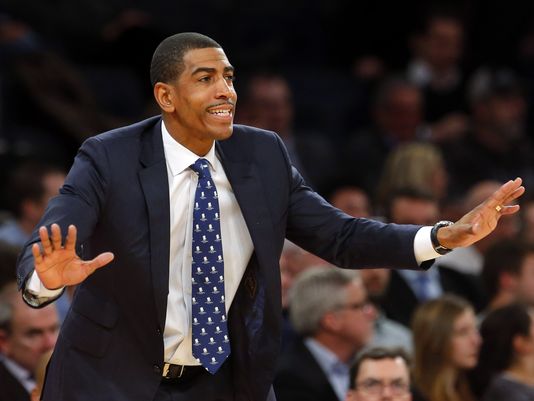UConn’s Regression Drops Huskies to AAC Basement
Posted by CD Bradley on January 4th, 2014On December 9, UConn was 9-0 after a series of dramatic wins, and had reached #9 in the most recent AP poll.

UConn coach Kevin Ollie was flying high a month ago, but now finds his team at the bottom of the AAC standings. (USAT)
A few days previous to that, after Shabazz Napier’s buzzer-beater knocked off Florida, we here at RTC wondered if the Huskies might be a legitimate Final Four contender. It’s safe to say that’s not a question getting raised in Storrs today. UConn went on to lose its first game of the season against Stanford on December 18, and now, after dropping both ends of a Texas road trip to Houston and SMU, find themselves in last place in the AAC standings. So what happened? Three things.
- Shabazz Napier did not in fact turn into Ray Allen. In their first nine wins, UConn was shooting a ridiculous 45 percent from three-point range, more than 10 percent higher than the year before. Both Napier and Niels Giffey were shooting at least 60 percent from distance. On the night they beat Florida, after shooting 11-of-24 from deep, we wrote: “If their shooting percentages eventually come back to earth, their record might follow.” And here we are. In their losses to Stanford, Houston and SMU, the Huskies shot a combined 18-of-60, or 30 percent from beyond the arc. Napier shot 5-of-17 in those three games, and is now shooting a still great but much more reasonable 47.8 percent for the season. UConn was never going to shoot 46 percent from three all year long, nor will they shoot 30 percent either. The truth, as always, is somewhere in the middle.
- UConn’s foes found their own hot streaks. The Texas sweep the Huskies suffered this week was due in large part to the great shooting of Houston and SMU. In particular, the Cougars, picked to finish near the bottom of the AAC, pulled the upset with better-than-average shooting. They knocked down 49 percent (26-of-53) from the field, 50 percent (7-of-14) from three, and 84 percent (16-of-19) on free throws, compared to season averages of 46 percent, 35 percent and 69 percent, respectively. In their last two games, UConn has allowed its opponents to shoot 46.6 percent from three; in its first 12 games, its foes shot 28.7 percent.
- They still can’t rebound. As we have seen, the team’s shooting has come and gone, but the one constant for UConn this season has been its poor rebounding. Going into Saturday’s game, the Huskies ranked #203 in the country in offensive rebounding percentage and #258 in defensive rebounding percentage, then proceeded to lower both metrics in the loss at SMU. The Huskies were outrebounded in all three of their losses, and have been beaten on the boards in 10 of their games this year. Kevin Ollie tried a lineup change, inserting freshman Amida Brimah into the starting group and bringing sophomore Phil Nolan off the bench, but it hasn’t made much of a difference. This was identified as the team’s biggest weakness coming into the season, and it has lived down the low expectations. If UConn can’t figure out a way to improve its rebounding on both ends of the floor, it almost certainly will be the reason the team won’t win the AAC or make a deep run in March.










































